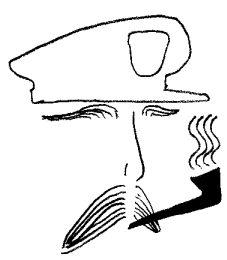

No. 2.—Onward to the Pole.
IT SEEMS AS if it were but yesterday (though in fact it was last Thursday) that I returned from my successful expedition to the Pole and faced those sincere expressions of admiration, which, heartfelt though they were, caused me no little discomfort, my native modesty being of such a quality that even faint praise is a considerable embarrassment to me. Nevertheless, my innate candor and my strict regard for the truth, no matter how inconvenient it may be to myself, compel me to confess that the praises heaped upon me were not entirely undeserved.
For the purpose of our expedition, we had been assigned the Margaret Cavendish, a small but adequate surveying ship. She had begun life as a brigantine in the Royal Navy under the name Prosperity; later she was re-rigged as a brig and rechristened the Elephant Shrew; and then, after considerable refurbishment, she reappeared as a barque under the name Abstraction. Some years later, owing to a clerical error, she was re-rigged as an omnibus and rechristened the 53H Homestead-Duquesne Via Homeville. Eventually she was rebuilt as a frigate and assigned to our expedition.
The Margaret Cavendish was, as I have indicated before, rather small for a frigate, and the space for our equipment and supplies was limited. Under the circumstances, some of my junior officers objected when I insisted on including a company of caterers, with all the tools of their profession; but I assured them that, in the bleak and icy wastelands of the north, we should all be much cheered by a well-catered meal now and then.
We set northward in late June, and for the occasion of our departure our caterers had made up a memorable feast, at the center of which they placed a decorative ice sculpture of the Margaret Cavendish herself. In order to prepare us for our northward voyage, the food was made entirely of blubber of the various sorts we might be expected to encounter.
The first few weeks of the voyage were uneventful, other than my having to quell a slight mutiny when the crew discovered that our caterers had brought nothing but blubber for the entire voyage. Eventually, however, we reached the frozen limit of liquid sea. We were forced to leave the Margaret Cavendish behind with a skeleton crew of caterers and cover the remainder of the distance by dogsled. Since we had brought no dogs, I dressed four ensigns in shaggy raccoon coats and hitched them to the sled that carried our supplies; the rest of the crew and I followed on foot.
I shall not weary you with the details of our long trek to the Pole. Suffice it to say that, when we finally reached it, we were somewhat dismayed to find a small band of Esquimaux already using it to string up their laundry. However, we were able to bribe them with a few trinkets, and they allowed us to place His Majesty’s flag at the top, above three pairs of knickers and a small tablecloth.
We went back by the same route; but you may imagine our dismay when we returned to discover that the Margaret Cavendish was no more! Caught between the edge of the ice pack and a floating iceberg, she had been crushed to splinters. The few men we had left behind had only just managed to salvage their kitchen equipment, which they had employed in fabricating a large tent from the sails, and furnishing it with folding chairs and a banquet table made from the splintered wood of the ship.
At this point my crew were of the opinion that all was lost, and we should doubtless perish in this frozen wasteland. I, however, retained my customary optimism; and to it I added a quality which I have sometimes been flattered to hear called good sense. Looking out to sea, I spied another iceberg, and it put me in mind of the feast we had enjoyed on our first night out of port. Turning to the caterers, I explained my idea, and they set to work at once.
It took a good two days of concerted effort, but the skills of the caterers were up to the task; for after all it was, but for the scale, no different from what I had already seen them accomplish. At the end of that time, they had carved an exact replica of the Margaret Cavendish from the ice all around us. We loaded our equipment on the new ship and set sail once again. I need not tell you, what everyone already knows; viz., that our sturdy ice-frigate made it as far as the extreme northern coasts of our own country, and that from there we were swiftly conveyed to face popular acclaim in the capital.
From this voyage I learned an important lesson, which is that, no matter how long the journey or how inhospitable the country, one should never deny oneself the comforts of home. I shall be certain to insist on a company of caterers in all my future voyages.